
Puget Sound is a sound on the northwestern coast of the U.S. state of Washington. It is a complex estuarine system of interconnected marine waterways and basins. A part of the Salish Sea, Puget Sound has one major and two minor connections to the Strait of Juan de Fuca, which in turn connects to the open Pacific Ocean. The major connection is Admiralty Inlet; the minor connections are Deception Pass and the Swinomish Channel.
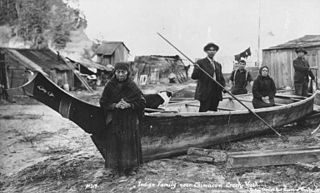
The Klallam are a Coast Salish people Indigenous to the northern Olympic Peninsula. The language of the Klallam is the Klallam language, a language closely related to the North Straits Salish languages. The Klallam are today citizens of four recognized bands: Three federally-recognized tribes in the United States and one band government in Canada. Two Klallam tribes, the Jamestown S'Klallam and Lower Elwha Klallam, live on the Olympic Peninsula, and one, the Port Gamble S'Klallam, on the Kitsap Peninsula in Washington state. In Canada, the Scia'new First Nation is based at Becher Bay on southern Vancouver Island in British Columbia.

The Swinomishpeople are a Lushootseed-speaking people Indigenous to western Washington state.

The eastern oyster —also called the Atlantic oyster, American oyster, or East Coast oyster—is a species of true oyster native to eastern North and South America. Other names in local or culinary use include the Wellfleet oyster, Virginia oyster, Malpeque oyster, Blue Pointoyster, Chesapeake Bay oyster, and Apalachicola oyster. C. virginica ranges from northern New Brunswick south through parts of the West Indies to Venezuela. It is farmed in all of the Maritime provinces of Canada and all Eastern Seaboard and Gulf states of the United States, as well as Puget Sound, Washington, where it is known as the Totten Inlet Virginica. It was introduced to the Hawaiian Islands in the 19th century and is common in Pearl Harbor.
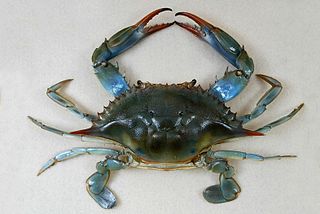
Callinectes sapidus, the blue crab, Atlantic blue crab, or, regionally, the Maryland blue crab, is a species of crab native to the waters of the western Atlantic Ocean and the Gulf of Mexico, and introduced internationally.
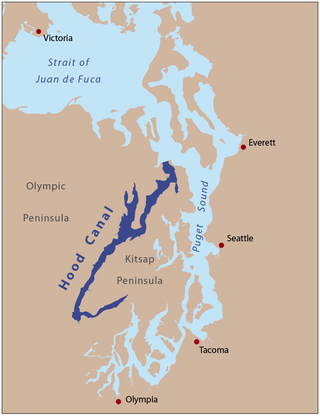
Hood Canal is a fjord forming the western lobe, and one of the four main basins of Puget Sound in the U.S. state of Washington. It is one of the minor bodies of water that constitute the Salish Sea. Hood Canal is not a canal in the sense of an artificial waterway—it is a natural feature.

The Dungeness crab makes up one of the most important seafood industries along the west coast of North America. Its typical range extends from Alaska's Aleutian Islands to Point Conception, near Santa Barbara, California. Dungeness typically grow 6-7 inches at their widest point and inhabit eelgrass beds and sandy bottoms. Its common name comes from the Dungeness Spit in the Strait of Juan de Fuca, Washington state, United States, which shelters a shallow bay inhabited by the crabs.

Puget Sound is a deep inlet of the Pacific Ocean in Washington, extending south from the Strait of Juan de Fuca through Admiralty Inlet. It was explored and named by Captain George Vancouver for his aide, Peter Puget, in 1792.
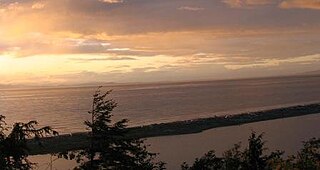
Dungeness is an unincorporated community in Clallam County, Washington, United States, located north of Sequim and on the Strait of Juan de Fuca. Dungeness has a number of waterfront residential communities, but also features the Dungeness Spit, a popular destination for locals and tourists.

Protection Island is an island located in the Strait of Juan de Fuca just north of Discovery Bay in northeastern Jefferson County, Washington, United States. The island has a land area of 379 acres (153 ha). It is a federally protected National Wildlife Refuge; boats are not permitted within 200 yards (180 m) for the safety and health of wildlife on and near the shores. There is only one individual still living on the island not associated with the government. Marty Bluewater has lifetime use of his inholding cabin on the island's southern bluffs. The island also houses a caretaker, a volunteer hired by the United States Fish and Wildlife Service, to watch over the island and take care of its many inhabitants. Boat trips from nearby Port Townsend, Washington provide ecotourism visits for viewing wildlife from the adjacent waters.

The Puget Sound king crab, is a species of king crab which inhabits the oceans of the Pacific coast of North America from Alaska to central California. Adults are orange, red and purple in color, while juveniles are either mostly orange or have small blotches of red and purple. They can be recognized by their blunt bumps on their carapace. Puget Sound king crabs are larger than the similar brown box crab, with an average size of 6–10 inches (15–25 cm).

Haliotis kamtschatkana, common name the northern abalone, threaded abalone, or pinto abalone, is a species of large sea snail, a marine gastropod mollusc in the family Haliotidae, the abalones.
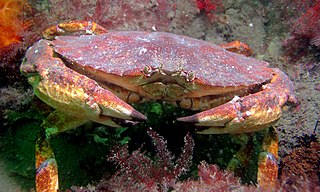
The red rock crab, one of several species known as red rock crabs, is a crab of the genus Cancer found on the western coast of North America. This species is commonly nicknamed the Pearl of the Pacific Northwest.
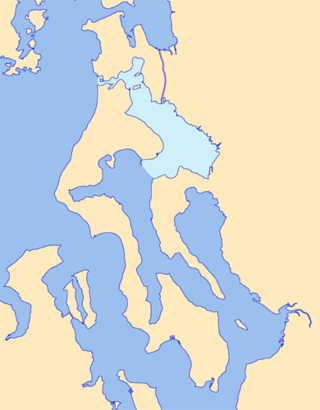
Skagit Bay is a bay and strait located in the U.S. state of Washington. It is part of the Whidbey Island Basin of Puget Sound. The Skagit River empties into Skagit Bay. To the south, Skagit Bay connects with the rest of Puget Sound via Saratoga Passage and Possession Sound. The boundary between Saratoga Passage and Skagit Bay is between Polnell Point on Whidbey Island and Rocky Point on Camano Island. To the northwest, Skagit Bay connects to the Strait of Juan de Fuca via the narrow strait of Deception Pass. A third waterway, the Swinomish Channel, connects Skagit Bay with Padilla Bay to the north.

Netarts Bay is an estuarine bay on the northern Oregon Coast of the U.S. state of Oregon, located about 5 miles (8.0 km) southwest of Tillamook. The unincorporated community of Netarts is located on the north end of the bay and Netarts Bay Shellfish Preserve, managed by Oregon Department of Fish and Wildlife, is located on the south side of the bay. The sand spit on the west side of Netarts bay is part of Cape Lookout State Park.
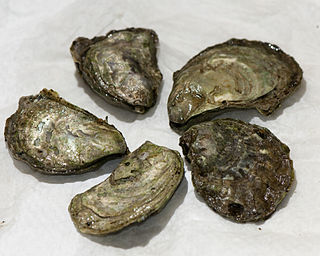
Ostrea lurida, common name the Olympia oyster, after Olympia, Washington in the Puget Sound area, is a species of edible oyster, a marine bivalve mollusk in the family Ostreidae. This species occurs on the northern Pacific coast of North America. Over the years the role of this edible species of oyster has been partly displaced by the cultivation of non-native edible oyster species.

The yelloweye rockfish is a species of marine ray-finned fish belonging to the subfamily Sebastinae, the rockfishes, part of the family Scorpaenidae. and one of the biggest members of the genus Sebastes. Its name derives from its coloration. It is also locally known as "red snapper", not to be confused with the warm-water Atlantic species Lutjanus campechanus that formally carries the name red snapper. The yelloweye is one of the world's longest-lived fish species, and is cited to live to a maximum of 114 to 120 years of age. As they grow older, they change in color, from reddish in youth, to bright orange in adulthood, to pale yellow in old age. Yelloweye live in rocky areas and feed on small fish and other rockfish. They reside in the East Pacific and range from Baja California to Dutch Harbor in Alaska.

Paralithodes platypus, the blue king crab, is a species of king crab from cold waters in the North Pacific Ocean and adjacent seas. Although blue king crabs are among the largest crabs in the world and reputedly may exceed 18 pounds (8.2 kg) in weight, they are generally smaller than red king crabs.
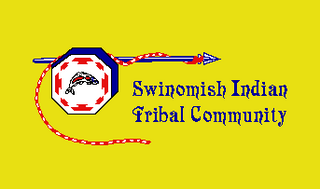
The Swinomish Indian Tribal Community, also known as the Swinomish Tribe, is a federally recognized tribe located on Puget Sound in Washington state. The tribe's population is primarily composed of Swinomish, Lower Skagit, Kikiallus, and Samish peoples and their descendants. Other populations on the reservation include the Suquamish and Upper Skagit.

South Puget Sound is the southern reaches of Puget Sound in Southwest Washington, in the United States' Pacific Northwest. It is one of five major basins encompassing the entire Sound, and the shallowest basin, with a mean depth of 37 meters (121 ft). Exact definitions of the region vary: the state's Department of Fish and Wildlife counts all of Puget Sound south of the Tacoma Narrows for fishing regulatory purposes. The same agency counts Mason, Jefferson, Kitsap, Pierce and Thurston Counties for wildlife management. The state's Department of Ecology defines a similar area south of Colvos Passage.





















